Intel Z68 Chipset & Smart Response Technology (SSD Caching) Review
by Anand Lal Shimpi on May 11, 2011 2:34 AM ESTAnandTech Storage Bench 2011
With the hand timed real world tests out of the way, I wanted to do a better job of summarizing the performance benefit of Intel's SRT using our Storage Bench 2011 suite. Remember that the first time anything is ever encountered it won't be cached and even then, not all operations afterwards will be cached. Data can also be evicted out of the cache depending on other demands. As a result, overall performance looks more like a doubling of standalone HDD performance rather than the multi-x increase we see from moving entirely to an SSD.
Heavy 2011—Background
Last year we introduced our AnandTech Storage Bench, a suite of benchmarks that took traces of real OS/application usage and played them back in a repeatable manner. I assembled the traces myself out of frustration with the majority of what we have today in terms of SSD benchmarks.
Although the AnandTech Storage Bench tests did a good job of characterizing SSD performance, they weren't stressful enough. All of the tests performed less than 10GB of reads/writes and typically involved only 4GB of writes specifically. That's not even enough exceed the spare area on most SSDs. Most canned SSD benchmarks don't even come close to writing a single gigabyte of data, but that doesn't mean that simply writing 4GB is acceptable.
Originally I kept the benchmarks short enough that they wouldn't be a burden to run (~30 minutes) but long enough that they were representative of what a power user might do with their system.
Not too long ago I tweeted that I had created what I referred to as the Mother of All SSD Benchmarks (MOASB). Rather than only writing 4GB of data to the drive, this benchmark writes 106.32GB. It's the load you'd put on a drive after nearly two weeks of constant usage. And it takes a *long* time to run.
First, some details:
1) The MOASB, officially called AnandTech Storage Bench 2011—Heavy Workload, mainly focuses on the times when your I/O activity is the highest. There is a lot of downloading and application installing that happens during the course of this test. My thinking was that it's during application installs, file copies, downloading and multitasking with all of this that you can really notice performance differences between drives.
2) I tried to cover as many bases as possible with the software I incorporated into this test. There's a lot of photo editing in Photoshop, HTML editing in Dreamweaver, web browsing, game playing/level loading (Starcraft II & WoW are both a part of the test) as well as general use stuff (application installing, virus scanning). I included a large amount of email downloading, document creation and editing as well. To top it all off I even use Visual Studio 2008 to build Chromium during the test.
The test has 2,168,893 read operations and 1,783,447 write operations. The IO breakdown is as follows:
| AnandTech Storage Bench 2011—Heavy Workload IO Breakdown | ||||
| IO Size | % of Total | |||
| 4KB | 28% | |||
| 16KB | 10% | |||
| 32KB | 10% | |||
| 64KB | 4% | |||
Only 42% of all operations are sequential, the rest range from pseudo to fully random (with most falling in the pseudo-random category). Average queue depth is 4.625 IOs, with 59% of operations taking place in an IO queue of 1.
Many of you have asked for a better way to really characterize performance. Simply looking at IOPS doesn't really say much. As a result I'm going to be presenting Storage Bench 2011 data in a slightly different way. We'll have performance represented as Average MB/s, with higher numbers being better. At the same time I'll be reporting how long the SSD was busy while running this test. These disk busy graphs will show you exactly how much time was shaved off by using a faster drive vs. a slower one during the course of this test. Finally, I will also break out performance into reads, writes and combined. The reason I do this is to help balance out the fact that this test is unusually write intensive, which can often hide the benefits of a drive with good read performance.
There's also a new light workload for 2011. This is a far more reasonable, typical every day use case benchmark. Lots of web browsing, photo editing (but with a greater focus on photo consumption), video playback as well as some application installs and gaming. This test isn't nearly as write intensive as the MOASB but it's still multiple times more write intensive than what we were running last year.
As always I don't believe that these two benchmarks alone are enough to characterize the performance of a drive, but hopefully along with the rest of our tests they will help provide a better idea.
The testbed for Storage Bench 2011 has changed as well. We're now using a Sandy Bridge platform with full 6Gbps support for these tests. All of the older tests are still run on our X58 platform.
AnandTech Storage Bench 2011—Heavy Workload
We'll start out by looking at average data rate throughout our new heavy workload test:
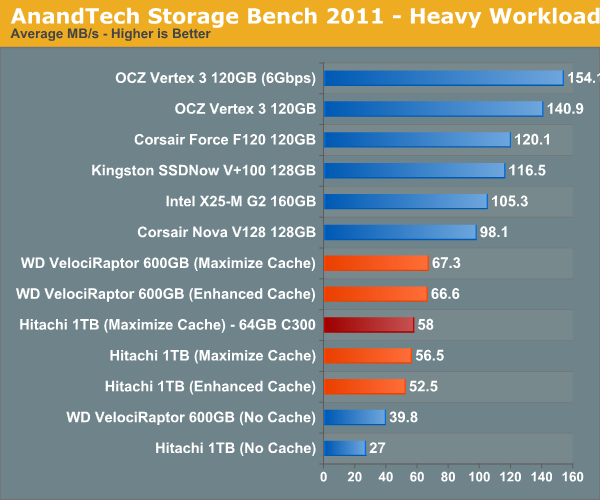
For this comparison I used two hard drives: 1) a Hitachi 7200RPM 1TB drive from 2008 and 2) a 600GB Western Digital VelociRaptor. The Hitachi 1TB is a good large, but aging drive, while the 600GB VR is a great example of a very high end spinning disk. With a modest 20GB cache enabled, the 3+ year old Hitachi drive is easily 41% faster than the VelociRaptor. We're still not into dedicated SSD territory, but the improvement is significant.
I also tried swapping the cache drive out with a Crucial RealSSD C300 (64GB). Performance went up a bit but not much. You'll notice that average read speed got the biggest boost from the C300 as a cache drive since it does have better sequential read performance. Overall I am impressed with Intel's SSD 311, I just wish the drive were a little bigger.
The breakdown of reads vs. writes tells us more of what's going on:
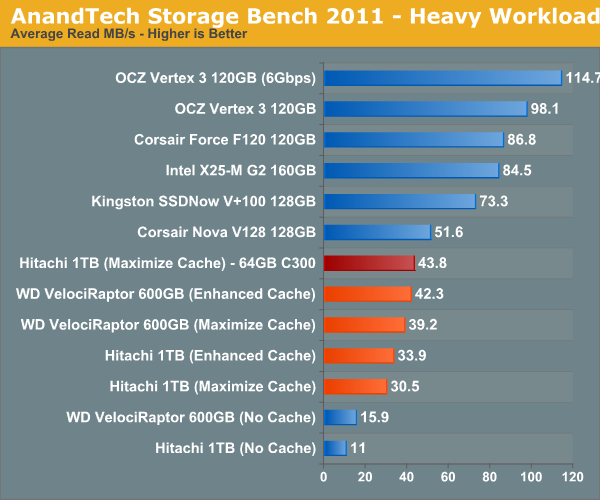
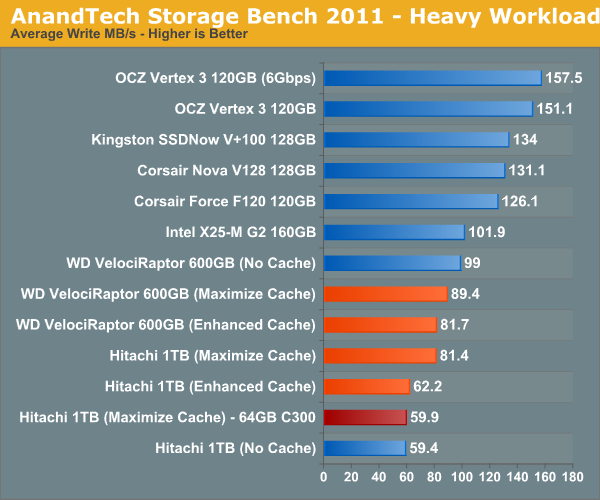
This isn't too unusual—pure write performance is actually better with the cache disabled than with it enabled. The SSD 311 has a good write speed for its capacity/channel configuration, but so does the VelociRaptor. Overall performance is still better with the cache enabled, but it's worth keeping in mind if you are using a particularly sluggish SSD with a hard drive that has very good sequential write performance.
The next three charts just represent the same data, but in a different manner. Instead of looking at average data rate, we're looking at how long the disk was busy for during this entire test. Note that disk busy time excludes any and all idles, this is just how long the SSD was busy doing something:
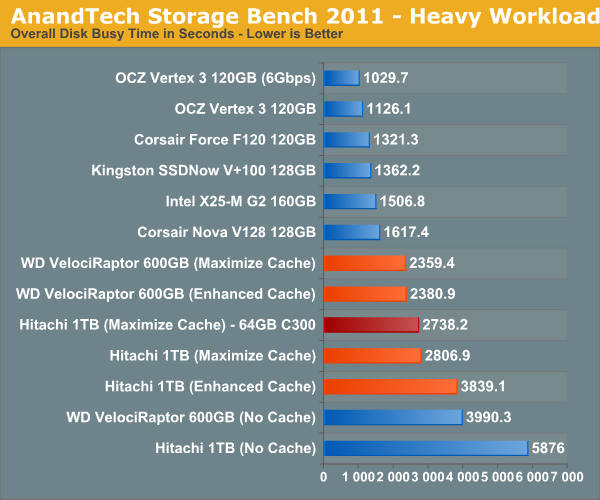
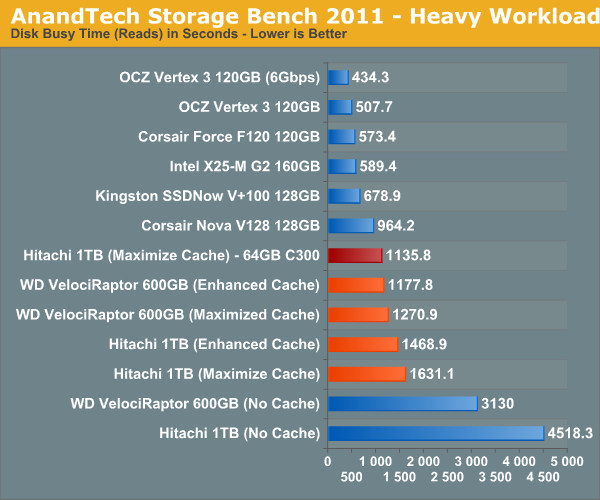











106 Comments
View All Comments
cbass64 - Wednesday, May 11, 2011 - link
RAID0 can't even compare. With PCMark Vantage a RAID0 with MD's gives you roughly a 10% increase in performance in the HDD suite. A high end SSD is is 300-400% faster in the Vantage HDD suite scores. Even if you only achieve 50% of the SSD performance increase with SRT you'd still be seeing 150-200% increase and this article seems to claim that SRT is much closer to a pure SSD than 50%.Obviously benchmarks like Vantage HDD suite don't always reflect real world performance but I think there's still an obvious difference between 10% and a couple hundred %...
Hrel - Thursday, May 12, 2011 - link
all I know is since I switched to RAID 0 my games load in 2/3 the time they used to. 10% is crazy. RAID 0 should get you a 50% performance improvement across the board; you did something wrong.DanNeely - Thursday, May 12, 2011 - link
Raid only helps with sequential transfers. If Vantage has a lot of random IO with small files it won't do any good.don_k - Wednesday, May 11, 2011 - link
Or the fact that it is an entirely software based solution. Intel's software does not, as far as I and google know, run on linux, nor would I be inclined to install such software on linux even if it were. So this is a non-starter for me. For steam and games I say get a 60-120gb consumer level ssd and call it a day. No software glitches, no stuff like that.This kind of caching needs to be implemented at the filesystem level if you ask me, which is what I hope some linux filesystems will bring 'soon'. On windows the outlook is bleak.
jzodda - Wednesday, May 11, 2011 - link
Are there any plans in the future of this technology being made available to P67 boards?Before I read this I thought it was a chipset feature. I had no idea this was being implemented in software at a driver level.
I am hoping that after a reasonable amount of time passes they make this available for P67 users. I understand that for now they want to add some value to this new launch but after some time passes why not?
michael2k - Wednesday, May 11, 2011 - link
Given that the drive has built in 4gb of flash, it would be very interesting to compare this to the aforementioned SRT. Architecturally similar, though it requires two drives instead of one. Heck, what would happen if you used SRT with a Seagate Momentus?kenthaman - Wednesday, May 11, 2011 - link
1. You mention that:"Even gamers may find use in SSD caching as they could dedicate a portion of their SSD to acting as a cache for a dedicated games HDD, thereby speeding up launch and level load times for the games that reside on that drive."
Does Intel make any mention of possible future software versions allowing user customization to specifically select applications to take precedence over others to remain in cache. For example say that you regularly run 10 - 12 applications (assuming that this work load is sufficient to begin the eviction process), rather than having the algorithm just select the least utilized files have it so that you can point to an exe and then it could track the associated files to keep them in cache above the priority of the standard cleaning algorithm.
2. Would it even make sense to use this in a system that has a 40/64/80 gig OS SSD and then link this to a HDD/array or would the system SSD already be handling the caching? Just trying to see if this would help offload some of the work/storage to the larger HDDs since space is already limited on these smaller.
Midwayman - Wednesday, May 11, 2011 - link
What is the long term use degradation like? I know without TRIM SSD's tend to lose performance over time. Is there something like trim happening here since this all seems to be below the OS level?jiffylube1024 - Wednesday, May 11, 2011 - link
Great review, as always on Anandtech!This technology looks to be a boon for so many users. Whereas technophiles who live on the bleeding edge (like me) probably won't settle for anything less than an SSD for their main boot drive, this SSD cache + HDD combo looks to be an amazing alternative for the vast majority of users out there.
There's several reasons why I really like this technology:
1. Many users are not smart and savvy at organizing their files, so a 500GB+ C drive is necessary. That is not feasible with today's SSD prices.
2. This allows gamers to have a large HDD as their boot drive and an SSD to speed up game loads. A 64GB SSD would be fantastic for this as the cache!
3. This makes the ultimate drop-in upgrade. You can build a PC now with an HDD and pop in an SSD later for a wicked speed bump!
I'm strongly considering swapping my P67 for a Z68 at some point, moving my 160GB SSD to my laptop (where I don't need tons of space but the boot speed is appreciated), and using a 30-60GB SSD as a cache on my desktop for a Seagate 7200.12 500GB, my favourite cheap boot HDD.
samsp99 - Wednesday, May 11, 2011 - link
Is the intel 311 the best choice for the $$, or would other SSDs of a similar cost perform better. For example the egg has OCZ Vertex 2 and other sandforce based drives in the 60GB range for approx $130. That is a better cache size than the 20GB of the intel drive.Sandforce relies on compression to get some of its high data rates, would that still work well in this kind of a cache scenario?